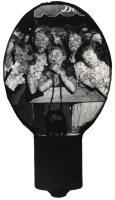
Robert Capa, [American soldiers landing on Omaha Beach, D-Day, Normandy, France], June 6, 1944 (2007.17.1)

Robert Capa, [American soldiers landing on Omaha Beach, D-Day, Normandy, France] [verso], June 6, 1944 (2007.17.1)

Robert Capa, [American soldiers landing on Omaha Beach, D-Day, Normandy, France], June 6, 1944 (1962.2005)

Robert Capa, [American soldiers landing on Omaha Beach, D-Day, Normandy, France] [verso], June 6, 1944 (1962.2005)

Life, June 19, 1944, pp. 26-27
The first wave of U.S. assault troops race through boiling surf to the beach. From the higher ground tapping machine guns have brought down several men in the water. This landing was one of the U.S. sea-borne attacks made on June 6 between St. Vaast-la Hougue and Isigny.
Troops crouch behind shallow-water obstacles installed by Germans. Tanks out of camera field to the right move up to silence German fire. These men waited for second wave of boats, then followed the tanks up the beach. Two landing craft may be dimly seen at left.
Crawling through the water, U.S. soldier edges toward the beach. Immense excitement of moment made Photographer Capa move his camera and blur picture. The Germans were still pouring machine-gun and shellfire down on the beach, apparently from concrete pillboxes.
Men in the second wave also take cover until all their boats have come in. Behind them men are jumping into water up to their necks. Their heads can be seen just above surface. Combat engineers cleared lanes through obstacles farther offshore so that boats could get in.
Life, June 19, 1944, pp. 26-27

Life, June 19, 1944, pp. 25-37
…Our preinvasion breakfast was served at 3:00 A.M. the mess boys of the U.S.S Chase wore immaculate white jackets and served hot cakes, sausages, eggs, and coffee with unusual zest and politeness. But the preinvasion stomachs were preoccupied, and most of the noble effort was left on the plates.
At 4:00 A.M. we were assembled on the open deck. The invasion barges were swinging on the cranes, ready to be lowered. Waiting for the first ray of light, the two thousand men stood in perfect silence; whatever they were thinking, it was some kind of prayer.
I too stood very quietly. I was thinking a little bit of everything: of green fields, pink clouds, grazing sheep, all the good times, and very much of getting the best pictures of the day. None of us was at all impatient, and we wouldn’t have minded standing in the darkness for a very long time. But the sun had no way of knowing that this day was different from all others, and rose on its usual schedule. The first-wavers stumbled into their barges, and – as if on slow moving elevators – we descended onto the sea. The sea was rough and we were wet before our barge pushed away from the mother ship. It was already clear that General Eisenhower would not lead his people across the Channel with dry feet or dry else…
My beautiful France looked sordid and uninviting, and a German machine gun, spitting bullets around the barge, fully spoiled my return. The men from my barge waded in the water. Waist-deep, with rifles ready to shoot, with the invasion obstacles and smoking beach in the background – this was good enough for the photographer. I paused for a moment on the gangplank to take my first real picture of the invasion. The boatswain, who was in an understandable hurry to get the hell out of there, mistook my picture-taking attitude for explicable hesitation, and helped me make up my mind with a well-aimed kick in the rear. The water was cold, and the beach still more than a hundred yards away. The bullets tore holes in the water around me, and I made for the nearest steel obstacle. A soldier got there at the same time, and for a few minutes we shared its cover. He took the waterproofing off his rifle and began to shoot without much aiming at the smoke-hidden beach. The sound of his rifle gave him enough courage to move forward and he left the obstacle to me. It was a foot larger now, and I felt safe enough to take pictures of the other guys hiding just like I was.
It was still very early and very gray for good pictures, but the gray water and the gray sky made the little men, dodging under the surrealistic designs of Hitler’s anti-invasion brain trust, very effective.
I finished my pictures, and the sea was cold in my trousers. Reluctantly, I tried to move away from my steel pole, but the bullets chased me back every time. Fifty yards ahead of me, one of our half-burnt amphibious tanks stuck out of the water and offered me my next cover. I sized up the situation. There was little future for the elegant raincoat heavy on my arm. I dropped it and made for the tank. Between floating bodies I reached it, paused for a few more pictures, and gathered my guts for the last jump to the beach.
Now the Germans played on all their instruments, and I could not find any hole between the shells and bullets that blocked the last twenty-five yards to the beach. I just stayed behind my tank, repeating a little sentence from my Spanish Civil War days, “Es una cosa muy seria. Es una coas muy seria.” This is a very serious business…
Robert Capa, Slightly Out of Focus, 1947, pp.139-140

